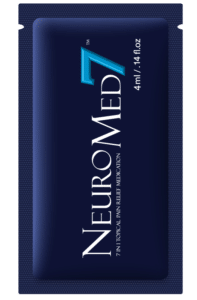numbing cream for chemo therapy
In order to numb the pain, many clinicians and patients opt to use numbing cream for chemo therapy. Therefore the common question is often: How to Apply Lidocaine Numbing Cream for Chemo Therapy?
What is Lidocaine Cream used for?
Your doctor may suggest or prescribe Lidocaine numbing cream for chemo therapy, to help numb the skin over your port. The cream is applied to the skin to decrease any pain you may feel when an IV is started, before accessing a port, and for other invasive procedures to the skin.
Do not use this cream over your incision until it is fully healed. This usually takes about 7 days after your port is placed.
How to Apply NeuroMed 7 Lidocaine Numbing Cream for Chemo Therapy Instructions:
- Apply the cream 15 – 30 minutes before your scheduled procedure.
- Wash your hands.
- Open tube (or sanitary, single-use packet)
- Find your port area.
- Point the tube and squeeze a small amount, about the size of a quarter onto your port area.
- Do not use gauze or band aids on cream (they will absorb the cream).
- Secure the dressing with tape, if needed.
- Wash hands to remove any cream that may be on them.
- If you get Lidocaine cream in your eyes, ears, nose, mouth, or on skin that has open cuts or scrapes, rinse thoroughly right away.
Who to call with questions:
If you have questions about applying Lidocaine numbing cream for chemo therapy, call the doctor or nurse who gave you the prescription or recommendation.
Many use NeuroMed 7 Topical Lidocaine Numbing Cream for Chemo Therapy Port Pain Management
CLINICAL PERSPECTIVE REGARDING THE USE OF NUMBING CREAM FOR CHEMO THERAPY:
Offering a topical anesthetic when accessing implanted ports is an important option for some patients. Minimally, patients should be aware of the option as part of the informed consent process (ie, being informed of alternative approaches to care). That said, there are times that the use of an anesthetic cream is impractical. For example, if the chemotherapy is being delivered by continuous infusion (eg, >24 hours, >96 hours, etc), using a topical anesthetic would require the therapy to stop for the period of time between removing the old non-coring needle and the time needed for the numbing agent to take effect, which is sometimes 30 to 45 minutes. – See more at: http://nursing.onclive.com/publications/oncology-nurse/2011/october-2011/what-would-you-do-should-topical-anesthetics-be-used-to-numb-the-skin-overlying-an-implanted-port-prior-to-noncoring-needle-insertion#sthash.ns0j71Op.dpuf
Michael Smart, RN, BSN, OCN®
Oncology Staff Nurse
Huntsville Hospital
Johns Hopkins Hospital
Huntsville, Alabama – See more at: http://nursing.onclive.com/publications/oncology-nurse/2011/october-2011/what-would-you-do-should-topical-anesthetics-be-used-to-numb-the-skin-overlying-an-implanted-port-prior-to-noncoring-needle-insertion#sthash.ns0j71Op.dpuf
Oncology Staff Nurse
Huntsville Hospital
Johns Hopkins Hospital
Huntsville, Alabama – See more at: http://nursing.onclive.com/publications/oncology-nurse/2011/october-2011/what-would-you-do-should-topical-anesthetics-be-used-to-numb-the-skin-overlying-an-implanted-port-prior-to-noncoring-needle-insertion#sthash.ns0j71Op.dpuf
Some things to consider when deciding to offer a topical anesthetic prior to non-coring needle insertion include: (1) how the anesthetic is administered (injected intradermal anesthetics may increase the risk of infection from the additional needle sticks); (2) when an anesthetic cream needs to be applied (because it may take an hour for the full numbing effect to occur, patient scheduling needs to be considered, and patients may need to apply the cream prior to arrival); and (3) what will be administered (eg, the duration of action of topical anesthetic creams is ≥2 hours, and if vesicants are administered, the anesthetic action of the cream may diminish the patient’s sensation of discomfort around the non-coring needle site). Topical anesthetic sprays (eg, ethyl chloride) need to be used with caution. They should be sprayed at a distance of 3 to 9 inches for 4 to 10 seconds or until the skin just turns white. The length of spray time depends on the skin’s sensitivity to cold and factors such as blood flow and skin depth. Over-spraying increases the risk of skin alteration (redness, irritation). Other considerations are the short duration of action (the anesthetic effect lasts up to 1 minute) and that ethyl chloride spray is not a sterile product (although it has passed the Microbial Limit Test in accordance with the United States Pharmacopeia).
Lisa Schulmeister, RN, MN, APRN-BC, OCN®, FAAN
Oncology Nursing Consultant
New Orleans, Louisiana – See more at: http://nursing.onclive.com/publications/oncology-nurse/2011/october-2011/what-would-you-do-should-topical-anesthetics-be-used-to-numb-the-skin-overlying-an-implanted-port-prior-to-noncoring-needle-insertion#sthash.ns0j71Op.dpuf
Oncology Nursing Consultant
New Orleans, Louisiana – See more at: http://nursing.onclive.com/publications/oncology-nurse/2011/october-2011/what-would-you-do-should-topical-anesthetics-be-used-to-numb-the-skin-overlying-an-implanted-port-prior-to-noncoring-needle-insertion#sthash.ns0j71Op.dpuf
NEUROMED 7 TOPICAL LIDOCAINE NUMBING CREAM
NeuroMed 7 is a 4% lidocaine topical anesthetic. It includes a novel chemical delivery system designed to improve onset time and efficacy. NeuroMed 7 is supplied in sanitary, single-use 4 gram (mL) packets to reduce the risk of cross-contamination. NeuroMed 7 is commonly known to reach its peak effect in as little as 15 minutes and provide an approximately one hour duration of efficacy.



